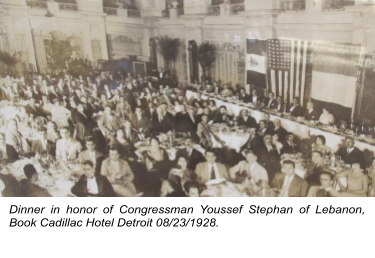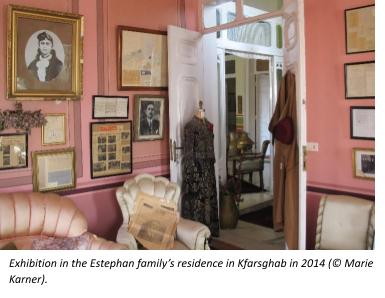Getting to Know Sheikh Youssef Stephan – Community Leaders as Role Models of Diasporic Village Communities
This article is authored by Marie Karner, a doctoral candidate at the Institute of Geography, Johannes Gutenberg University Mainz, Germany. It is part of her dissertation project that studies different Lebanese diasporic village communities. She uses a multi-sited-research design to focus on their practices of reproduction and community development. In January 2018, she was a visiting scholar at the Khayrallah Center and conducted archival research related to her case studies.
Within the Lebanese diaspora, some communities have maintained a sense of village identity. One might question why their village of origin remains their central reference point. This article shows that discourses on deceased community leaders strengthen emotional ties with the place of origin and reinforce solidarity among members. The achievements of community leaders, as well as how their activities are narrated, presented and valued, contribute to the reproduction of diasporic village communities.
The example of Sheikh Youssef Stephan (*1890, † 1947), a former minister and community leader from the village of Kfarsghab in North Lebanon, provides insights into why he remained important to his community beyond his death. His great-great-grandfather is considered to be one of the five founding fathers of the village.[1] He was one of the local village Sheikhs on the rise in the second half of the 18th century, and received the privilege to collect taxes within his district[2] during the time when Mount Lebanon was part of the Ottoman Empire.[3]
About a century later, the first villagers left Kfarsghab, heading to Australia and the United States, as well as Brazil and other countries. Living abroad, they appreciated the supportive role of the Stephan or Estephan family in their village of origin: “No one who has watched closely the untiring efforts and never-failing kindness, hospitality, and consideration can entertain a doubt that they are competent, efficient, and zealous, and always ready to help their fellow-townmen, morally and financially, and they are worthy of our confidence and esteem.”[4]
Moreover, Sheikh Youssef Stephan is remembered as one of the successful political leaders of Lebanon during the French mandate.[5] In 1926/7, he served as a member of the first Senate and represented North Lebanon as a Member of Parliament during several terms. He was also appointed Minister of Interior and Defense during the presidency of Émile Eddé.[6]
In 1928, Sheikh Youssef Stephan was delegated, as representative for migration affairs, to visit the Lebanese overseas. In France, the United States, New Zealand and Australia, the Government as well as the Lebanese and Kfarsghabi communities held many functions in his honor.[7] His journey was driven by the objective to develop Lebanon’s economy,[8] use Lebanon’s natural resources independently and counteract the increasing employment of French capital.[9] As a shareholder in financial, commercial and industrial companies, he was able to mobilize many emigrants from Kfarsghab to back e.g. the Qadisha Power Company with investments during the 1920s and 1930s.[10]
Although the political involvement of the Estephan family ended in the mid-1950s, the deceased leaders were not forgotten by community members worldwide. Descendants from Kfarsghab have settled in Sydney (Australia), Easton (PA) and Providence (RI) (United States) and engage with their heritage in village associations and Maronite churches. With the help of print and online media, information about the life and the origin of Sheikh Youssef Stefan’s family is circulated until today. Several editions of the community magazine “AKLA News”, issued between 1968 and 2000 by the Australian Kfarsghab Lebanese Association (AKLA) in Sydney, remind readers of his political, economic, cultural and philanthropic contributions.[11]
The importance of Sheikh Youssef Stephan is also emphasized during informative events like the exhibition commemorating 125 years of Kfarsghab Migration in Sydney, organized by the Australian Kfarsghab Association (AKA) in 2012. Similarly, the living room of the imposing residence of the Estephan’s in Kfarsghab is used by family members to display newspaper articles, historic photographs and letters to and from previous Sheikhs.
With the emergence of websites like www.labans.com during the 1990s and 2000s, as well as other digital platforms, detailed information about the Estephan family became widely accessible. In 2014, the post “Getting to Know…? Sheikh Youssef Stephan” was published in the Facebook group “Kfarsghab Lebanon”,[12] which has become the prime platform for communication among community members worldwide. As soon as photographs, newspaper clippings or copies of documents related to Sheikh Youssef Stephan are posted, readers exchange their knowledge, emotions and analyses in the comment section, for instance: “It is so nice to discover these pictures. Lil Kfarsghab making a Big impact =).”
Until today, community members address descendants of Sheikh Youssef Stephan with the title “Sheikh” and acknowledge them in an unquestioned manner: “I’ve known nothing of the Sheikh-system and how that came about. But when he and his brother were here, we’d go and see them because we still respect that position.“[13]
The initiatives of the great-great nephew of Sheikh Youssef Stephan best exemplify how one of the current Sheikhs tries to follow in his footsteps. He feels a sense of historical responsibility to preserve the support system promoted by previous Sheikhs, also because he himself profited greatly from it: “For me it is definitively the kind of feel-good factor, it’s my sort of social responsibility, but also being from this family. (…) I feel it is my obligation. The Kfarsghab community helped me with my education. Due to this solidarity – it is not like paying them back, but it is kind of like this is what brothers do, you know, we look after each other.”[14] To reestablish community ties, he reproduces the initiatives of his ancestors (e.g. overseas visits, village feasts) and makes use of modern tools (e.g. Facebook) to induce sustainable changes in the village (such as youth-focused projects).
Apart from other elements, like common routines, traditions and village associations, discourses on community leaders reinforce awareness of a common place of origin. The outlined initiatives range from storytelling to educational work with the help of modern communication media. The narratives portray the community leader as a role model for descendants. Commitment to the community, a good education and ambition are associated with economic success and social recognition, as enshrined in the collective memory of Sheikh Youssef Stephan.
Footnotes:
[1] AKLA, “History of Kfarsghab – Part V: a) Abu Youssef Elias Family”, AKLA News 8 (1) (1975), p. 5-7.
[2] Youssef El-Laban, “Sheikhs in the 18th Century” (2003), http://www.labans.com/sheikhs.htm (02/19/2018).
[3] Akram Fouad Khater, Embracing the Divine. Passion and Politics in the Christian Middle East (New York: Syracuse University Press: 2011).
[4] Simon Coorey, “Letter to Kfarsghab” from the Over-Seas League in Redfern (08/26/1919).
[5] Farid Antoun, “Death of Sheikh Youssef Stephan”, Sada El Shimal Newspaper 1520 (12/06/1947).
[6] AKLA, “Recalling History”, AKLA News 31 (1) (1998), p. 14.
[7] Salloum Antoun Mokarzel, “About Syria and Syrians. Lebanese Representatives in the United States”, The Syrian World 3 (3) (09/1928), p. 49-50; Emissary from Liban. Mediterranean Republic. Immigration Investigation”, New Zealand News (10/09/1928).
[8] “Emigrants and their Motherland”, As-Shaab New York (03/01/1929).
[9] Salloum Antoun Mokarzel, “The Changing East”, The Syrian World 4 (5) (01/1930), p. 22-25.
[10] Ibid., “Qadisha Power Now in Trouble”, The Syrian World (11/24/1933), p. 6.
[11] AKLA, (1998), s.a., p. 14.
[12] Marcel Stephan, cited after Najla Khoury, “Getting to Know…? “Sheikh Youssef Stephan.”, Facebook Group Kfarsghab Lebanon (03/20/2014).
[13] Interview with the President of the AKA in Sydney (12/23/2014).
[14] Interview with the current Sheikh in Kfarsghab (07/19/2014).
- Categories:





